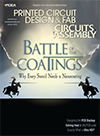News
The microprocessor market will hit nearly $30 billion, 90% of it coming from devices for computing systems, according to IC Insights in its monthly report.
Moreover, flash sales will reach $15.6 billion by year-end. up 33%,
following a 51% gain in 2003. DSPs is expected to grow 26%, to $7.7
billion, the firm said.
C-MAC designs and manufactures electronics products, typically for harsh environments. It has design and manufacturing facilities in the U.K., France, Belgium and Canada, where it performs thick-film printing on ceramic and other substrates, and builds surface mount and other advanced assemblies.
The new C-MAC board includes Duncan Ralph, chief executive; Andrew Gray and David Stanton of Francisco Partners, and Ajay Shah of Shah Capital Partners.
ESD Assn Offers Webinar to Demystify Standard
If you are interested in developing an ESD program that meets the criteria of ANSI/ESD S20.20, the ESD Association is offering an online course to help. Ron Gibson, chairman of the ESDA Standards Committee and co-author of the ANSI/ESD S20.20, will facilitate the program scheduled for Nov. 17, 2004, at 1 p.m., EDT.
The 60-minute presentation will include an explanation of criteria required for an S20.20 compliant facility; discussion of issues including grounding, packaging, training and documentation; and a brief question and answer session. Cost is $95.
For more information, contact (315) 339-6937; info@esda.org.
ANGLETON, TX, Oct. 21 -- Benchmark Electronics saw third-quarter profits rise 40% as sales jumped by $50 million.
The EMS maker said September quarter earnings were $18 million, up from $12.9 million last year, a new third-quarter high. Revenue was $505 million, up from $455 million.
Analysts forecast sales of $496 million for the quarter.
Operating margins rose to 4.8% and inventories were up $13 million, to $290 million, the company said.
Benchmark guided for fourth-quarter sales of $505 million to $530 million.
Celestica Reports GAAP Loss on $2.2b in Revenue
10-21-2004
by Mike Buetow
TORONTO, Oct. 21 -- Celestica Inc. today said September quarter revenue was $2.2 billion, up 33% from last year and in line with previous guidance, despite lower telecom demand.
The EMS maker reported a GAAP net loss of $22.3 million, includes pretax restructuring charges of $47.7 million, including $16.6 million for inventory writedowns and a $12 million gain associated with the sale of the Power Systems business.
Last year Celestica reported a GAAP net loss of $65 million, including restructuring and other charges of $49.1 million.
"Despite lower demand this quarter from some of our largest communications and IT customers, we continued to expand margins, reduce SG&A spending, improve customer diversity, act on unprofitable or non-core activities and generate healthy cash flow from operations," said chief executive Steve Delaney, in a press statement.
Delaney called end-market demand "less stable" than earlier in the year. The company anticipates December quarter revenue in the range of $2.1 billion to $2.3 billion, with a softening in end-market demand balancing normal seasonality.
In a research note, Deutsche Bank said it remains cautious on the sector, including Celestica, due to slowing demand and aggressive pricing. "Celestica`s fourth quarter guidance speaks volumes to the anemic end-market environment (flat quarter-on-quarter in the [usuallyl] seasonally strong fourth quarter," the firm said.
Year-to-date Celestica's revenue has risen 35% to $6.51 billion and the GAAP net loss is $56.2.
Celestica said it has ceased creating its own reference designs and will exit its channel distribution activities for these products. Said Delaney: "We remain committed to providing enterprise-wide server solutions to our customers, including product design services, manufacturing, logistics services, and after-market services".
Press Releases
- Tagarno Sees Strong US Sales Growth in 2025, Driven by T50 and Software Demand
- Kimball Electronics Sets Date for Ribbon-Cutting at New Indianapolis Medical Manufacturing Facility
- Nordson’s SELECT Synchro Selective Soldering System Helps Kamstrup Advance Automation, Increase Output 20%, and Reclaim 6 Meters of Factory Floor Space
- Pinnacle Technology Group, Now PTG Electronics, Launches New Brand Identity, Strengthening Its Commitment to Innovation and Progress


